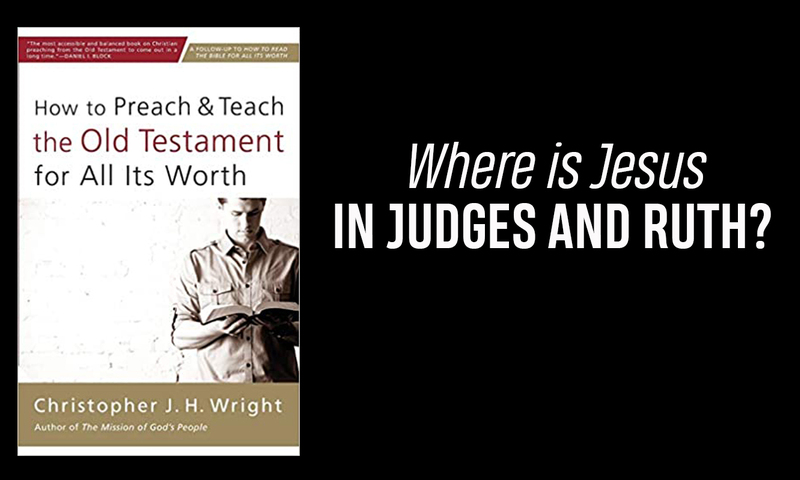Jesus‚Äô statement to the disciples on the road to Emmaus has long provided Christians with a hermeneutical key to reading the Old Testament: ‚Äúbeginning with Moses and all the Prophets, he interpreted to them in all the Scriptures the things concerning himself‚ÄĚ (Luke 24:27 ESV). Unfortunately, Luke does not record how exactly Jesus interpreted the Old Testament in this case. In this post we will analyze several means of finding Jesus in the Old Testament, focusing on Judges and Ruth as a test case. We will organize our material in this section through categories developed by Christopher Wright in his book How to Preach and Teach the Old Testament for All Its Worth.
First, narrative texts allow us to connect the Old Testament story to the broader story of God‚Äôs plan for the world.[1] The most natural way to do this in Judges and Ruth is through the genealogy at the end of Ruth, which moves the focus from the characters of the story to their descendant David. This allows easy movement to the bigger picture of the Old Testament and then on to the New Testament and later stages of YHWH‚Äôs drama.[2] The connection is not as clear in Judges, though the move can be made by examining the role of the judges in the broader history of Israel. Barry Webb says ‚ÄúIn Judges we are on a trajectory on which we might, with good reason expect to see ‚Ķ some anticipations of God‚Äôs future work in David and in Christ.‚ÄĚ[3]
Second, some OT texts allow us to connect to Jesus through promises, usually as embodied in covenants.[4] While some indirect connections to the Davidic Covenant can be made through the genealogy at the end of Ruth, this method of connecting Jesus to the OT text is not very productive for Judges and Ruth.
Third, many narratives provide us with characters and events that are similar to Jesus,[5] what many refer to as typology. The early church fathers provide many examples of typology that many readers today would view as fanciful. For example, the lion killed by Samson is a type of Christ according to Caesarius of Arles because ‚Äúto us Christ is a lion in whose mouth we found the food of honey after his death.‚ÄĚ[6] Sidney Greidanus identifies such events as the defeat of the Philistines and the role of the judges as types of the coming greater victory of God and leadership role of Jesus.[7] Alistair Begg sees typology in the redemption and marriage of Ruth by Boaz, which ‚Äúforeshadows Christ, who in himself is the only one who has the right to take and bear as his own all that spoils and ruins, all the loss, hurt, disaster, alienation, brokenness, and sinful messed-up-ness of things.‚ÄĚ[8] Daniel Hawk says Naomi‚Äôs ‚Äúsense of estrangement from Yahweh was echoed by Christ who, in torment on the cross, quoted a lament‚Ķ In so doing Christ sanctified Israel‚Äôs traditions of protest and opened a way for seeing them as profound expressions of faith.‚ÄĚ[9]
Fourth, many narratives also provide us with characters and events that offer a contrast to Jesus.[10] For example, Greidanus shows how while Gideon is a type of Christ in some ways (such as when he tears down the pagan altar), he contrasts with Jesus when he makes an ephod.[11] Williams emphasizes that in contrast to the sinful judges, ‚Äúthe ultimate deliverer, Jesus Christ, has no flaws.‚ÄĚ[12]
Fifth, the Old Testament calls for responses from God‚Äôs people that are similar to what we are called to do today.[13] Just as the people of Israel were not to follow the gods of the surrounding nations but to follow YHWH, so Christians are to reject the gods of our world and follow Jesus. According to Alistair Begg, ‚ÄúGod was reaching into Ruth‚Äôs life across the barriers of race, and her picture was painted in the great scene in Revelation: persons ‚Äėfrom every tribe and language and people and nation‚Äô (Rev. 5:9). Those people are worshiping King Jesus, who descended from this woman Ruth.‚ÄĚ[14] People believe in Jesus today in the same way that Ruth believed in YHWH.
Sixth, the Old Testament displays the same kind of grace that we see demonstrated in Jesus.[15] As YHWH demonstrated grace to the Israelites through sending judges to them, so Jesus shows us grace today in empowering us to defeat sin. An example is Bryan Chapell’s sermon from Judges 6-8 (the story of Gideon) focused on God using the useless.[16]
The majority of the methods of finding Jesus in Judges and Ruth land in Wright‚Äôs third and fourth categories: finding similarities and contrasts between OT events and the life of Jesus. While many examples in this category are helpful, interpreters‚ÄĒboth ancient and modern‚ÄĒsometimes focus too much on this method and make fanciful connections with Jesus that are simply not based in the Old Testament text. In addition, these approaches tend to over-emphasize the humanity of Jesus as the expense of his divinity. However, this category can still be very profitable if used in responsible ways.
Wright‚Äôs first two categories‚ÄĒmaking connections based on the overarching history and promises‚ÄĒappear only occasionally in the literature on finding Jesus in Judges and Ruth. The final two categories‚ÄĒcalling for similar responses and YHWH displaying similar grace that he shows today‚ÄĒare dependent upon identifying Jesus closely with YHWH in the Old Testament, emphasizing his divinity. These methods appear often in preaching of the Old Testament, but are underutilized in discussions of preaching Jesus in the Old Testament.
We hope that this survey of various means of finding Jesus in Judges and Ruth inspires you to think in new ways about the search for Jesus in the Old Testament!
Notes
- Christopher J. H. Wright, How To Preach and Teach the Old Testament for All Its Worth (Grand Rapids: Zondervan, 2016), 64‚Äď66.
- Alistair Begg, ‚ÄúFrom a Foreigner to King Jesus (Ruth),‚ÄĚ in The Scriptures Testify 51¬‹ņÚ Me: Jesus and the Gospel in the Old Testament, ed. D. A. Carson (Wheaton: Crossway, 2013), 64‚Äď65.
- Barry G. Webb, Judges, New International Commentary on the Old Testament (Grand Rapids: Eerdmans, 2012), 56‚Äď57.
- Wright, How To Preach and Teach the Old Testament, 66‚Äď68.
- Wright, How To Preach and Teach the Old Testament, 68‚Äď73.
- John R. Franke, ed., Joshua, Judges, Ruth, 1-2 Samuel, ACCS 4 (Downers Grove: InterVarsity, 2005), 147.
- Sidney Greidanus, Preaching Christ from the Old Testament: A Contemporary Hermeneutical Method (Eerdmans, 1999), 260.
- Begg, ‚ÄúFrom a Foreigner to King Jesus (Ruth),‚ÄĚ 64.
- L. Daniel Hawk, Ruth, Apollos Old Testament Commentary 7B (Downers Grove, IL: IVP Academic, 2015), 68.
- Wright, How To Preach and Teach the Old Testament, 74‚Äď79.
- Greidanus, Preaching Christ from the Old Testament, 273.
- Michael Williams, How To Read the Bible through the Jesus Lens: A Guide to Christ-Focused Reading of Scripture (Grand Rapids: Zondervan, 2012), 39.
- Wright, How To Preach and Teach the Old Testament, 79‚Äď81.
- Begg, ‚ÄúFrom a Foreigner to King Jesus (Ruth),‚ÄĚ 62.
- Wright, How To Preach and Teach the Old Testament, 81‚Äď84.
- Bryan Chapell, Christ-Centered Sermons: Models of Redemptive Preaching (Grand Rapids: Baker, 2013), 41‚Äď54.
 51¬‹ņÚ
51¬‹ņÚ



.jpg)

